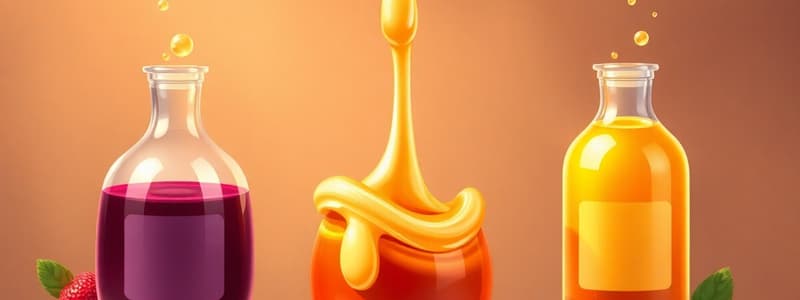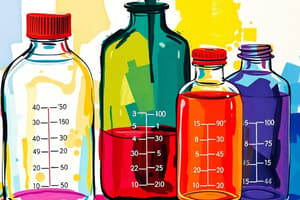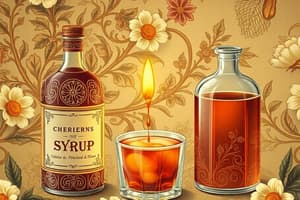Podcast
Questions and Answers
What is the difference between nonmedicated and medicated syrups?
What is the difference between nonmedicated and medicated syrups?
Nonmedicated syrups contain only flavoring agents, while medicated syrups contain both flavoring agents and medicinal substances.
What is the primary purpose of syrups?
What is the primary purpose of syrups?
- To mask the taste of unpleasant-tasting drugs (correct)
- To provide a concentrated source of sugar
- To increase the absorption of medications
- To act as a preservative
Which of the following is NOT a common ingredient in syrups?
Which of the following is NOT a common ingredient in syrups?
- Starch (correct)
- Glycerin
- Sorbitol
- Sucrose
All syrups must contain a preservative to prevent microbial growth.
All syrups must contain a preservative to prevent microbial growth.
What is the most common method for preparing syrups?
What is the most common method for preparing syrups?
What is the main reason why excessive heat should be avoided when preparing syrups?
What is the main reason why excessive heat should be avoided when preparing syrups?
What is the primary function of a colorant in a syrup?
What is the primary function of a colorant in a syrup?
Describe the percolation method for preparing syrups.
Describe the percolation method for preparing syrups.
Why is it important to ensure compatibility between the drug substance and the other components of a syrup?
Why is it important to ensure compatibility between the drug substance and the other components of a syrup?
Which of the following preparations is commonly used for treating respiratory disorders?
Which of the following preparations is commonly used for treating respiratory disorders?
Why is Syrup, NF considered a good example of a stable syrup?
Why is Syrup, NF considered a good example of a stable syrup?
Alcohol is a common preservative used in syrups that significantly contributes to their stability.
Alcohol is a common preservative used in syrups that significantly contributes to their stability.
Flashcards
Syrups
Syrups
Concentrated aqueous preparations of sugar (or sugar substitutes) with or without flavoring and medicinal substances.
Nonmedicated Syrups
Nonmedicated Syrups
Syrups containing flavoring but no medicinal substances; flavored vehicles.
Medicated Syrups
Medicated Syrups
Syrups containing a therapeutic agent.
Simple Syrup
Simple Syrup
Signup and view all the flashcards
Sucrose-based syrups
Sucrose-based syrups
Signup and view all the flashcards
Non-Sucrose-based syrups
Non-Sucrose-based syrups
Signup and view all the flashcards
Components of Syrups
Components of Syrups
Signup and view all the flashcards
Inversion (in syrups)
Inversion (in syrups)
Signup and view all the flashcards
Syrup Preparation Methods
Syrup Preparation Methods
Signup and view all the flashcards
Ipecac Syrup
Ipecac Syrup
Signup and view all the flashcards
Oral Liquid Dosage Forms
Oral Liquid Dosage Forms
Signup and view all the flashcards
Study Notes
Syrups
- Syrups are concentrated aqueous preparations of sugar or sugar substitutes, possibly with flavorings and medicinal agents.
- Flavored syrups without medicinal agents are called non-medicated syrups.
- Common non-medicated syrups include cherry syrup (47% cherry juice), cocoa syrup (cocoa powder suspension), orange syrup (orange peel/citric acid), and raspberry syrup (48% raspberry juice).
- Simple syrup is 85% sucrose in purified water. It can be a base for flavored and medicated syrups.
- Medicated syrups are used to deliver medication
- Syrups are often used for children and the elderly due to difficulty swallowing solid dosage forms.
- Syrups can be solutions or suspensions, depending on chemical/physical properties of the drug.
- Syrups contain sweeteners (often sucrose), preservatives, flavorings, colorants.
- Often contain solvents, solubilizing agents, thickeners, or stabilizers for commercial syrups.
- Water-soluble, stable drugs in aqueous solutions can be added to flavored syrups.
Syrup Components
- Sugar/Sweetener: Usually sucrose, but may be replaced in some cases with other sugars (sorbitol, glycerin, propylene glycol) or non-sucrose substances (methylcellulose, hydroxyethylcellulose).
- Preservatives: Used to prevent microbial growth. Common are benzoic acid , sodium benzoate and methylparabens, propylparabens, or butylparabens.
- Flavorants: Used to enhance taste. May include volatile oils, vanillin, and other natural or synthetic ingredients. Flavoring must be water soluble or, sometimes, using alcohol to dissolve some flavorings.
- Colorants: Used to improve visual appeal. Colorants should be compatible and water soluble or miscible with other components. Ideally they don't interact with other components.
Syrup Preparation
- With Heat: The sugar is dissolved in the water by heating. Preservative and other components are added to the solution. The solution cools and is stored. This method is usually faster to prepare.
- Without Heat (Agitation): Mixing sucrose with purified water to dissolve it with agitation without heating. Other ingredients are added after the solution is made. This method avoids potentially harming temperature-sensitive ingredients.
Syrup Additives
- Materials for preparation and compounding of syrup must be of USP-NF quality and FDA-approved.
- Preservatives. Amounts of preservatives required depend on the proportions of water available for microbial growth, characteristics (e.g., antimicrobial activity) of the other components, and preservative properties.
Storage
- Important to store syrups in tightly sealed containers.
- Storing syrups at lower temperatures is also beneficial for long-term stability and preservation.
- Sucrose concentration is important to prevent microbial growth. High sucrose concentration helps to prevent crystallization and microbial growth.
Syrups for Specific Use
- Antihistamine syrup - Example formulation included in the text.
- Acetaminophen syrup - Example formulation included in the text.
Percolation
- A method of extracting active drug components. Sucrose or syrup may add to the extract. Active ingredients can be extracted and separated. Example: ipecac syrup. A syrup of ipecac is prepared by percolating ipecac and adding glycerin and simple syrup.
- The method can be a two-step process (extracting then making the syrup).
Other Important Considerations
- Compatibility of components in syrups must be considered. Stability of the syrup can be impacted.
- Inversion of sucrose (hydrolysis of sucrose by heat into glucose and fructose) can affect the sweetness and coloration of a solution, so must be carefully controlled and monitored.
- Preservatives are necessary for longer shelf-life unless the final product is intended for immediate use.
- Syrups containing heat-labile ingredients require special preparation methods and a careful process.
Studying That Suits You
Use AI to generate personalized quizzes and flashcards to suit your learning preferences.




